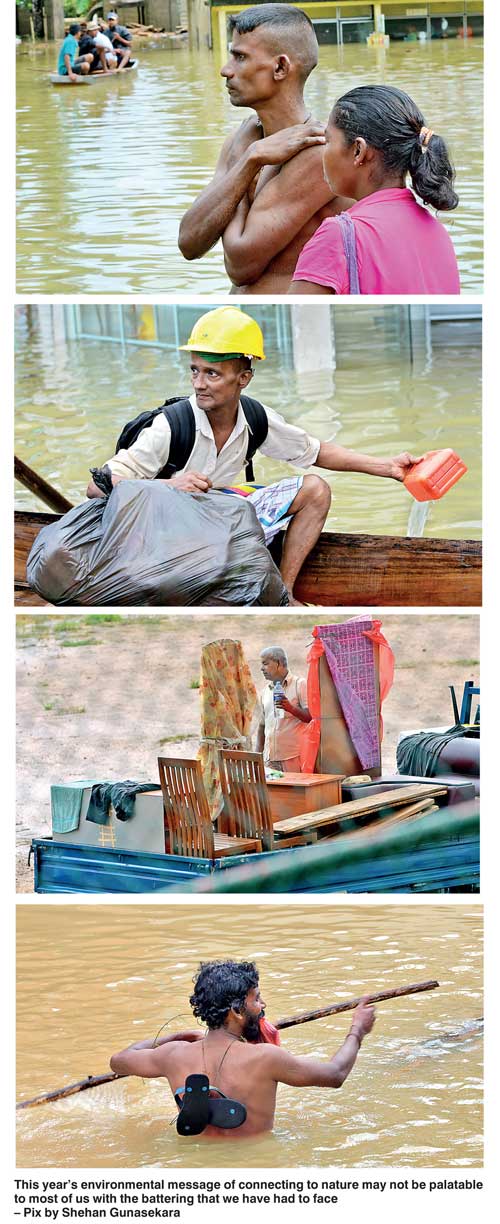Tuesday Mar 04, 2025
Tuesday Mar 04, 2025
Thursday, 8 June 2017 00:00 - - {{hitsCtrl.values.hits}}
Sahana software (www.sahanafoundation.org), which was developed after the tsunami by a few Sri Lankans, is an open source disaster management software and is identified as the world’s most popular open-source information management system for disaster and humanitarian aid management
The deluge that caused so much havoc, loss of many lives and property and a huge number of environmental refugees (if I may use the term as it was an environmental response that led to so many displaced in one’s own area) has opened up many a discussion and debate. 
To the theorist and climate evangelists, perhaps the frequency of extreme events will necessarily increase and we will unfortunately have to experience many more of such events in the coming years. That is certainly not good news, in the absence of any mechanism and an enlightened response; usually after an event CEB will be giving free electricity, Central Bank will not be collecting any loan repayments, TV channels will be delivering dry rations instead of programs, social media will be subjected to a deluge of who did what with choice adjectives and the country will never be the same again.
The assessment and the plan of the country’s economic performance with a high percentage of growth and for a continuous period of years that will get us into the rich boys’ club appears to be a distant dream under these conditions and potential circumstances. We can have these aspirations, and may actually realise the dream instead of the nightmare, but with an approach that learns, anticipates, plans, designs, innovates and delivers.
Late Bernard Shaw once said that all problems have solutions and they are technical in nature. May be that is not quite right but one thing is certain, the solutions we usually seek are the least technical and that is a fact which is hard to dispute and the net result of such a consistent approach is a future with a certainty of uncertainty!
Connecting to nature
This year’s environmental message of connecting to nature may not be palatable to most of us with the battering that we have had to face. We may be excused for not quite looking forward to such an intimate reconnect to nature. Yet please do not forget that environmental problems can be usually defined post analysis really as a human behavioural problem and in that context the moment we begin to value and understand nature, which is what is expected through this message, much of the problems can be solved.
This is where we may actually modify Shaw’s statement, yet the technology that we speak of today is different from the technologies of Shaw’s era.
Another group of environmental refugees who were displaced due to the Meethotamulla dump collapse are worried that they will be forgotten amidst the new interest over the displaced due to rain and landslides. Yes the number at Meethotamulla compared to the new episode that faced the country is small and knowing how our minds work and actions take place perhaps they are justifiable in the way of thinking!
Let us not forget that we are paying multiple prices due to our neglect. However the column is to place some thoughts on record for consideration and calling for process changes.
Changes needed
Human beings dislike change and usually are reticent to change even when circumstances are quite compelling. What is brand value to marketers is cognitive inertia to neuroscientists!
Those who were at Meethotamulla had been told – but may not be in no uncertain terms! Those who were living in landslide prone areas too had been informed – especially those who have been unfortunate to be positioned in high risk zones.
Yes it is not feasible to pack and leave and occupy another place as soon an order is delivered. The request to move is not usually coupled with facilitation to ensure easier relocation either, so the people are somewhat left between the devil and the deep blue sea.
Of course one cannot forget there are a few who see an opportunity in such circumstances and opt to play their cards differently and some parts of the political system too aid and abet such scenarios. Until of course a sudden downpour of 500 mm plus rainfall occurs unknown to even those who are supposed to be on the watch out for such events.
Doing the wrong things with the right tools
Sri Lanka is known to have a more active SIMS than its population. We are usually ahead of the curve in mobile technology deployment – not as creators but as users. We speak of empowerment yet when it matters most the screens do not show any meaningful advice and one may go down with phones in their pants. We appear to do all the wrong things with the right tools.
We do have the connectivity but lack the means to feed the system with information and analysis to meet situations of this nature. The monitoring mechanism is not quite up to date. Certainly they are not connected and we have not prioritised such connectivity either.
While our own students do engage in research on predictive modelling of rain over locations via the monitoring of clouds, use satellite imagery, terrain topographies and artificial intelligence to develop war games to others, etc., the picture on prime time news of the water level gauge at Nagalagam Street indicates a frozen history of technology applications when it comes to managing ourselves – or are they using library photos?
It is the same situation when we as patients religiously carry our details to the doctor while some of us keep outselves awake with pots of coffee (certainly not tea!) and ensure medical transcriptions are done perfectly so as to assure the doctor elsewhere that their records are kept accurately with cloud access and enabling the patient to be treated to best of their ability.
We do indeed use the state-of-the-art vehicles to arrive at a site and then declare lack of money and then press on with the assessment of the need to use appropriate technologies for most of the situations. The technical tales from our isle with the exceptions of technologies deployed in test playing grounds, mobile telephony systems and some car sales outlets can be date stamped with dates from the middle of last century!
Sahana software
I am intrigued when I hear of Sahana software (www.sahanafoundation.org), which was developed after the tsunami by few Sri Lankans. It is an open source disaster management software and is identified as the world’s most popular open-source information management system for disaster and humanitarian aid management. Since its development and emergence in Sri Lanka it has been deployed in over 30 countries.
Today the Sahana Foundation resides in Los Angeles and the software is deployed across many countries with Sri Lanka of course spared! The qualities of the product are quite enticing. It has been used in New York when Hurricane Sandra came in and in many more. Is it wishful thinking to think why we are not interested in deploying what we ourselves have developed?
I am also aware of SLINTEC’s development of the pressure sensor that was used to sense flash flood situations and then to communicate to warn those who are in the proximity with the knowledge based on mobile communication systems. The sensing was coupled to a warning for those who may be heading in the wrong direction. This was another product that did not go beyond the prototyping stage.
It is said that in the Ratnapura town it did not take long for the water level to drastically rise and many had been caught unaware. The use of such developments and certainly Sahana can be significant.
We also know that our network capability to sense and transmit rainfall data is not strong. We still run mostly with weather stations that were primarily set up to support agriculture. As per sensing and predicting landslides we are used to extrapolate from rainfall data rather than eliciting information from potential risk areas directly.
Scientific process and procurement process
It must be stated that scientists are aware of the shortcomings and there are those who commit themselves to do their best under quite trying circumstances and meagre resources. The scientific process is almost always trumped by the procurement process that treats the purchases under four broad headings and follows a procedure that the old British rulers may be quite proud of.
I have indicated many a time if the dismantling of one thing that could lead to a significant improvement to research and development is to use Schumpeter terminology – the enforcement of creative destruction of the existing procurement procedures. The frustration of waiting for six months to get one item without which nothing can happen is common to so many in our system and ignoring this by all so far is inexcusable!
The reason may be that as I view how we operate is strictly demarcating policies and science, quite similar to oil and water. There is no mixing and no interest in getting to know each other. When science is not influencing the decision-making process, where we on the other hand see emotion running rampant, the consequences are not something one can be proud of.
The pain of submergence has been one of our own creations. It is true that one who may have endured is not the one who did create, yet over the years we have to think that the guilt has to be shared by us all, at least as far as inaction goes.
Discover Kapruka, the leading online shopping platform in Sri Lanka, where you can conveniently send Gifts and Flowers to your loved ones for any event including Valentine ’s Day. Explore a wide range of popular Shopping Categories on Kapruka, including Toys, Groceries, Electronics, Birthday Cakes, Fruits, Chocolates, Flower Bouquets, Clothing, Watches, Lingerie, Gift Sets and Jewellery. Also if you’re interested in selling with Kapruka, Partner Central by Kapruka is the best solution to start with. Moreover, through Kapruka Global Shop, you can also enjoy the convenience of purchasing products from renowned platforms like Amazon and eBay and have them delivered to Sri Lanka.
Discover Kapruka, the leading online shopping platform in Sri Lanka, where you can conveniently send Gifts and Flowers to your loved ones for any event including Valentine ’s Day. Explore a wide range of popular Shopping Categories on Kapruka, including Toys, Groceries, Electronics, Birthday Cakes, Fruits, Chocolates, Flower Bouquets, Clothing, Watches, Lingerie, Gift Sets and Jewellery. Also if you’re interested in selling with Kapruka, Partner Central by Kapruka is the best solution to start with. Moreover, through Kapruka Global Shop, you can also enjoy the convenience of purchasing products from renowned platforms like Amazon and eBay and have them delivered to Sri Lanka.